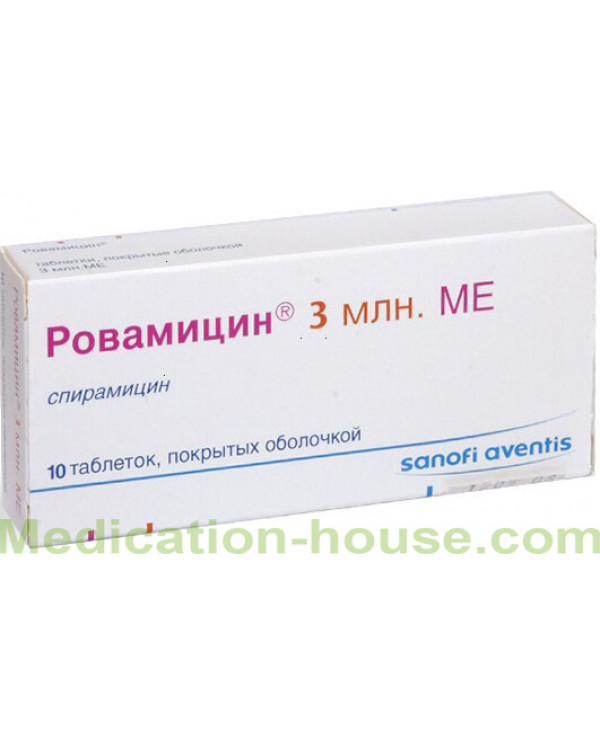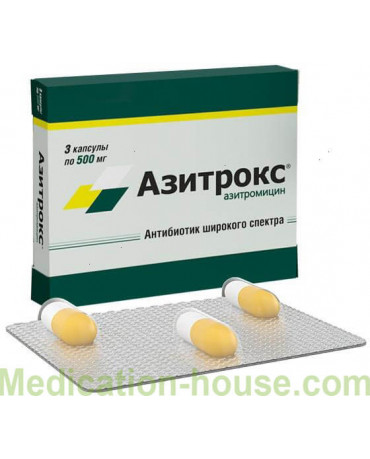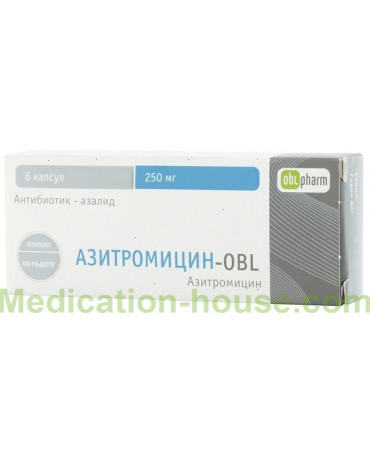Rovamycine user manual
You can buy Rovamycine on this page
Spiramycin, the active ingredient of Rovamycine, penetrates into the tissue cells and creates a higher concentration there than in the blood plasma. This may explain the effectiveness of the antibacterial action on intracellular microorganisms.
Composition and release form
Available Rovamycine in the form of tablets and powder. The tablets are packaged in blisters of 8 and 5 pieces, 2 blisters per pack. The lyophilized powder intended for preparation of the solution, which is used for intravenous administration, is placed in a vial and in a package.
The active ingredient of the drug - spiramycin:
In 1 tablet - 1.5 million IU or 3 million IU;
In 1 bottle of lyophilisate - 1.5 million IU.
Clinico-pharmacological group: macrolide antibiotic group.
Indications for use
After determining the sensitivity to antibiotics, any diseases caused by susceptible microorganisms can be treated.
Diseases recommended for empirical therapy:
Angina;
Pneumonia;
Toxoplasmosis;
Sinusitis (incl. Sinusitis);
Chronic bronchitis in the acute stage;
Infectious - dependent bronchial asthma;
Infectious diseases of the genitourinary system in men and women;
In order to prevent meningitis;
Infectious diseases of the skin (erysipelas, pyoderma);
Infectious diseases of the musculoskeletal system (osteomyelitis, periodontitis, purulent arthritis).
pharmachologic effect
In the instructions for Rovamycine, it is reported that the drug has an antibacterial effect, inhibiting protein synthesis in bacteria cells. Also, depending on the dosage of the drug, it may have a bacteriostatic or bactericidal effect.
Streptococci, staphylococcus (including Staphylococcus aureus), meningococcus, whooping cough sticks, diphtheria bacillus, mycoplasma, chlamydia, toxoplasma, hemophilic bacillus, legionella, clostridia, leptospira and other microorganisms are sensitive to Rovamycine. Some types of streptococci, staphylococci, enterobacter, acinetobacter, etc. are insensitive to Spiramycin. There is a cross-resistance of microorganisms between Erythromycin and Rovamycine (Spiramycin).
The accumulation of the drug occurs in phagocytes, which contributes to the activity of the drug in relation to intracellular bacteria, in particular to chlamydia, mycoplasma, toxoplasmosis.
Instructions for use
According to the instructions for use pills Rovamycine taken orally, swallowing whole and squeezed the necessary amount of water.
Adults appoint 2-3 tab. 3 million IU or 4-6 tab. 1.5 million IU (ie 6-9 million IU) per day. The daily dose is divided into 2 or 3 doses. The maximum daily dose is 9 million IU.
In children and adolescents aged 6 to 18, only tablets 1.5 million ME should be used.
In children older than 6 years, the daily dose ranges from 150-300 thousand ME per kg of body weight, which is divided into 2 or 3 doses to 6-9 million ME. The maximum daily dose in children is 300 thousand ME per kg of body weight, but if the child’s body weight is more than 30 kg, it should not exceed 9 million ME
Intravenous administration of Rovamycine is used to treat respiratory diseases (upper and lower sections) in adults: acute pneumonia, chronic bronchitis and pneumonia, bronchial asthma (infectious-dependent).
Contraindications for Rovamycine
Do not use the drug in such cases:
breastfeeding period;
hypersensitivity to the drug;
age up to 6 years for tablets 1.5 million IU, up to 18 years for tablets 3 million IU and lyophilisate;
deficiency of glucose-6-phosphate dehydrogenase (due to the risk of developing acute hemolysis);
congenital or acquired lengthening of the QT interval, when combined with drugs that can cause ventricular tachycardia such as "pirouette": IA and class III antiarrhythmic drugs, benzamide group antipsychotics, some phenothiazine neuroleptics, pentamidine, halofantrine, moxifloxacin and other drugs, other antipsychotics, pentamidine, halofantrin, moxifloxacin and other drugs bepridil, difemanil, cisapride, erythromycin, administered intravenously, mizolastine, vincamine, administered intravenously (for lyophilisate).
Side effects
Taking tablets Rovamycine may be accompanied by the development of negative reactions from various organs and systems, which include:
Cardiovascular system: extremely rare - prolongation of the QT interval on the electrocardiogram (ECG);
The nervous system is a transient violation of the sensitivity of the skin (paresthesia).
Blood and red bone marrow - destruction of red blood cells (acute hemolysis).
Gastrointestinal: nausea, diarrhea, vomiting; extremely rarely - pseudomembranous colitis; frequency is unknown (when administered orally) - acute colitis, ulcerative esophagitis, when using high doses due to cryptosporidiosis in AIDS patients - damage to the intestinal mucosa (2 cases);
The liver and hepatobiliary system is a transient decrease in the functional activity of the liver, accompanied by the development of cholestatic and mixed hepatitis.
Allergic reactions - skin rash, itching, swelling and rash, resembling a nettle burn (nettle rash), marked swelling of tissues in the face and external genital organs (angioedema of the Quinckie), systemic allergic reaction with a critical decrease in blood pressure and organ failure (anaphylactic shock).
With the development of manifestations of adverse reactions, the doctor decides individually on the question of withdrawal of tablets. The doctor individually solves, depending on their nature and severity.
Pregnancy and lactation
Rovamycine can be prescribed during pregnancy according to indications.
There is extensive experience in the use of the drug Rovamycine during pregnancy. Reducing the risk of transmission of toxoplasmosis to the fetus during pregnancy is observed from 25% to 8% when using the drug in the first trimester, from 54% to 19% in the second trimester and from 65% to 44% in the third trimester. No teratogenic or fetotoxic effect was observed.
In the appointment of the drug Rovamycine during lactation should stop breastfeeding, since it is possible penetration of spiramycin into breast milk.
Reviews
Larisa
The child had very bad bronchitis, the doctor prescribed Rovamycine, only because the child was wildly afraid of injections ... it helped almost immediately ... after 2 days, even the doctor said that the injections could not be done ... the child had no side effects, although he was allergic to penicillin series ...
Terms of sell
You don't need a prescription to buy Rovamycine.



